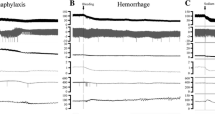Summary
1. Studies on 23 additional dogs have entirely confirmed our previous reports showing that anoxemia causes a delay in gastric evacuation.
2. Removing, replacing or supplementing the pylorus prevents the delay caused by the less severe grades of anoxemia. This indicates that the delay resulting from mild anoxemia is due to pylorospasm. The more severe grades of anoxemia cause additional delay probably by directly depressing the motility of the stomach.
3. The pylorospasm is on a vagospastic basis since it disappears when the vagus fibers to the pylorus are cut without disturbing those to the stomach. Atropine cannot be used for this demonstration because it simultaneously depresses the motility of the stomach.
4. After removal or denervation of the pylorus mild anoxemia may cause faster evacuation because the vagospastic effect on gastric motility now becomes manifest. However, the postoperative normal emptying time is not shorter than the normal (760 mm.).
5. We conclude that the delay in gastric emptying time during anoxemia is at first,i. e., until a critical threshold is reached, upon a vagospastic pylorospastic basis. After this threshold is passed additional delay is caused by a loss in gastric motility.
Similar content being viewed by others
References
Crisler, G., and Van Liere, E. J.: The Effect of Anoxemia on the Emptying Time of the Stomach.Am. J. Physiol., 101:26, June, 1932.
Van Liere, E. J.; Crisler, G., and Robinson, D.: Effect of Anoxemia on the Emptying Time of the Stomach.Arch. Int. Med., 51:796, May, 1933.
Eyster, J. A. E., and Meek, W. J.: Experiments on the Origin and Propagation of the Impulse in the Heart.Heart, 5:119, 137, 227, 1914.
Greene, C. W., and Gilbert, N. C.: Studies on the Response of the Circulation to Low Oxygen Tension: VI. The Cause of the Changes Observed in the Heart During Extreme Anoxemia.Am. J. Physiol., 60:155, March, 1922.
Van Liere, E. J., and Crisler, G.: A Study of Vagospasm: The Action of the Vagus on the Heart During Acute Anoxemia.Am. J. Physiol., 105:469, August, 1933.
Greene, C. W.: Oxygen Supply and Metabolic Level.The Medical Herald and Physiotherapist, Kansas City, Mo., May, 1926.
Crisler, G.; Van Liere, E. J., and Booher, W. T.: The Effect of Anoxemia on the Digestive Movements of the Stomach.Am. J. Physiol., 102:629, December, 1932.
Fetter, D.; Barron, L., and Carlson, A. J.: The Effect of Induced Hyperthyrodism on the Gastro-Intestinal Motility of Vagotomized Dogs.Am. J. Physiol., 101:605, September, 1932.
Meek, W. J., and Herron, R. C.: The Effect of Vagotomy on Gastric Emptying Time.Am. J. Physiol., 109:221, August, 1934.
Author information
Authors and Affiliations
Additional information
From Department of Physiology, West Virginia University, Morgantown.
Rights and permissions
About this article
Cite this article
Crisler, G., van Liere, E.J. & Wiles, I.A. The mechanism of the delay in gastric emptying time caused by anoxemia. American Journal of Digestive Diseases and Nutrition 2, 221–224 (1935). https://doi.org/10.1007/BF03000779
Received:
Issue Date:
DOI: https://doi.org/10.1007/BF03000779




